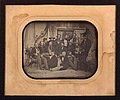- The Daguerreotype was the first practical photographic process.
- Invented by Daguerre in the 1830s and announced to the public in 1839.
- It was made using a copper plate, coated with a thin layer of silver.
- A positive image becomes visible on the plate after the development process.
- The images have to be viewed correctly for the image to appear as positive.
- The image is physically fragile and tarnishes rapidly due to pollutants in air - they were sealed behind glass (with a thin brass or similar metal matt as a spacer), and usually put in a frame or case immediately after production.
- The camera produces a single image, and daguerreotypes are not easily reproducible.
- The image is highly detailed with and can reproduce a delicate range of tones.
- Unless exposed using a mirror in front of the camera lens, they are a reversed image of the subject.
- The great majority of vintage daguerreotypes were portraits of single individuals - other subjects are rare. Usually these are three quarter length or simply heads and shoulders.
- Colour was added to some daguerreotypes by hand, usually with finely ground pigment on a dry brush. Tarnishing can also sometimes give various colours to parts of the image.
- Most daguerreotypes are small images - generally fractions made by cutting the 'whole plate' size of 6.5 x 8.5 inches into 4, 6, 9 or 16 smaller plates before use; (1/16 plate images are around 1" x 2".)
- Daguerreotypes were used in commercial photography from around 1840 to 1855 in Europe, and until around 1860 in the USA.
Daguerreotypes - Current use |
There has been a considerable revival in the process in recent years, although the number of workers is still relatively small, due to the rather tricky nature of the process. Considerable experience is needed to produce consistent results.
Modern workers have the advantage of exposure meters to gauge exposure, although the readings need to be extrapolated due to the low speed of the material. The meters also measure all visible light, while the daguerreotype is only sensitive to ultraviolet and a part of the blue region.
Most modern workers use Becquerel development to avoid the safety hazard of hot mercury, mercury vapour being a dangerous cumulative poison. A convenient approach is to carry this out in the darkslide, covering the aperture with a sheet of rubylith (deep red) film, and pulling out the darkslide. In sunlight, a properly exposed plate will develop in around 15-25 minutes with this method.
|






|

